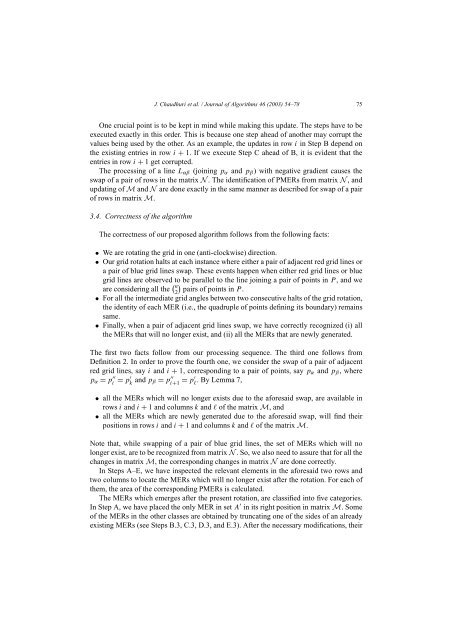LARGEST EMPTY.pdf - Library(ISI Kolkata) - Indian Statistical Institute
LARGEST EMPTY.pdf - Library(ISI Kolkata) - Indian Statistical Institute
LARGEST EMPTY.pdf - Library(ISI Kolkata) - Indian Statistical Institute
You also want an ePaper? Increase the reach of your titles
YUMPU automatically turns print PDFs into web optimized ePapers that Google loves.
J. Chaudhuri et al. / Journal of Algorithms 46 (2003) 54–78 75<br />
One crucial point is to be kept in mind while making this update. The steps have to be<br />
executed exactly in this order. This is because one step ahead of another may corrupt the<br />
values being used by the other. As an example, the updates in row i in Step B depend on<br />
the existing entries in row i + 1. If we execute Step C ahead of B, it is evident that the<br />
entries in row i + 1 get corrupted.<br />
The processing of a line L αβ (joining p α and p β ) with negative gradient causes the<br />
swap of a pair of rows in the matrix N . The identification of PMERs from matrix N ,and<br />
updating of M and N are done exactly in the same manner as described for swap of a pair<br />
of rows in matrix M.<br />
3.4. Correctness of the algorithm<br />
The correctness of our proposed algorithm follows from the following facts:<br />
• We are rotating the grid in one (anti-clockwise) direction.<br />
• Our grid rotation halts at each instance where either a pair of adjacent red grid lines or<br />
a pair of blue grid lines swap. These events happen when either red grid lines or blue<br />
grid lines are observed to be parallel to the line joining a pair of points in P ,andwe<br />
are considering all the ( n<br />
2)<br />
pairs of points in P .<br />
• For all the intermediate grid angles between two consecutive halts of the grid rotation,<br />
the identity of each MER (i.e., the quadruple of points defining its boundary) remains<br />
same.<br />
• Finally, when a pair of adjacent grid lines swap, we have correctly recognized (i) all<br />
the MERs that will no longer exist, and (ii) all the MERs that are newly generated.<br />
The first two facts follow from our processing sequence. The third one follows from<br />
Definition 2. In order to prove the fourth one, we consider the swap of a pair of adjacent<br />
red grid lines, say i and i + 1, corresponding to a pair of points, say p α and p β ,where<br />
p α = p<br />
i ′′ = p′ k and p β = p<br />
i+1 ′′ = p′ l<br />
. By Lemma 7,<br />
• all the MERs which will no longer exists due to the aforesaid swap, are available in<br />
rows i and i + 1andcolumnsk and l of the matrix M,and<br />
• all the MERs which are newly generated due to the aforesaid swap, will find their<br />
positions in rows i and i + 1andcolumnsk and l of the matrix M.<br />
Note that, while swapping of a pair of blue grid lines, the set of MERs which will no<br />
longer exist, are to be recognized from matrix N . So, we also need to assure that for all the<br />
changes in matrix M, the corresponding changes in matrix N are done correctly.<br />
In Steps A–E, we have inspected the relevant elements in the aforesaid two rows and<br />
two columns to locate the MERs which will no longer exist after the rotation. For each of<br />
them, the area of the corresponding PMERs is calculated.<br />
The MERs which emerges after the present rotation, are classified into five categories.<br />
In Step A, we have placed the only MER in set A ′ in its right position in matrix M.Some<br />
of the MERs in the other classes are obtained by truncating one of the sides of an already<br />
existing MERs (see Steps B.3, C.3, D.3, and E.3). After the necessary modifications, their
















